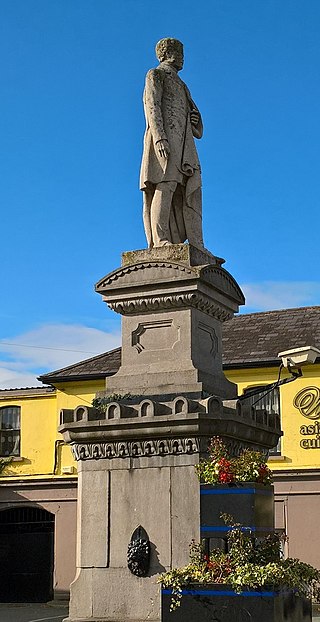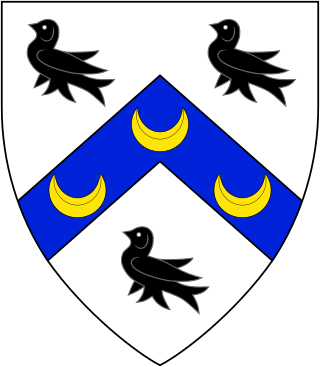There have been a number of creations of baronets with the surname Smith.
The Clifford-Constable Baronetcy, of Tixall in the County of Staffordshire was given to Thomas Hugh Clifford-Constable, originally Thomas Hugh Constable Clifford. The title in the Baronetage of the United Kingdom was created on 22 May 1815 and at the request of Louis XVIII of France.
There have been five baronetcies created for people with the surname Napier, three in the Baronetage of England, one in the Baronetage of Nova Scotia and one in the Baronetage of the United Kingdom. As of 2014 two of the creations are extant.
The Seely Baronetcy, of Sherwood Lodge in Arnold in the County of Nottingham and Brook House in Brooke on the Isle of Wight, is a title in the Baronetage of the United Kingdom. It was created on 19 February 1896 for the industrialist Charles Seely (1833–1915), son and namesake of Charles Seely (1803–1887). The first baronet's grandson, the third Baronet, was created Baron Sherwood, of Calverton in the County of Nottingham, in the Peerage of the United Kingdom in 1941. The peerage became extinct on his death, but he was succeeded in the baronetcy by his younger brother, the fourth Baronet. As of 2019, the title is held by the latter's grandson, the sixth baronet.

There have been three baronetcies created for persons with the surname Foster, all in the Baronetage of the United Kingdom. Two of the creations are extinct.

There have been seventeen baronetcies for persons with the surname Stewart, ten in the Baronetage of Nova Scotia, one in the Baronetage of Ireland and six in the Baronetage of the United Kingdom. See also Steuart baronets, Henderson-Stewart baronets, MacTaggart-Stewart baronets and Stewart-Clark baronets.

There have been nine baronetcies created for persons with the surname Cooper, one in the Baronetage of England, one in the Baronetage of Ireland and seven in the Baronetage of the United Kingdom.

There have been seven baronetcies created for persons with the surname Russell, three in the Baronetage of England and four in the Baronetage of the United Kingdom.
There have been five baronetcies created for persons with the surname Evans, one in the Baronetage of Ireland and four in the Baronetage of the United Kingdom. All of the baronetcies are now extinct.
There have been six baronetcies created for persons with the surname King, one in the Baronetage of Ireland, one in the Baronetage of Great Britain and four in the Baronetage of the United Kingdom. Three of the creations are extant as of 2007.

The Ferguson Davie Baronetcy, of Creedy in the County of Devon, is a title in the Baronetage of the United Kingdom. It was created on 9 January 1847 for Henry Ferguson Davie, a General in the Army and Member of Parliament for Haddington from 1847 to 1878. Born Henry Ferguson, he was the husband of Frances Juliana Davie, only surviving sister of Sir John Davie, 9th Baronet, of Creedy, and niece and heiress of Sir Humphrey Davie, 10th Baronet, of Creedy. In 1846 he assumed by Royal licence the additional surname of Davie. The second Baronet represented Barnstaple in the House of Commons as a Liberal.

The Leeds Baronetcy, of Croxton Park in the County of Cambridge, is a title in the Baronetage of the United Kingdom. It was created on 31 December 1812 for George Leeds. He was an equerry to Prince Augustus Frederick, Duke of Sussex. The Croxton Park estate in Cambridgeshire had been in the Leeds family since circa 1568. As of 2011 the presumed ninth and present Baronet, a resident of Canada, has not successfully proven his succession and is not on the Official Roll of the Baronetage.

There have been seven baronetcies created for persons with the surname Watson, one in the Baronetage of England, one in the Baronetage of Great Britain and five in the Baronetage of the United Kingdom. One creation is extant as of 2016.
There have been three baronetcies created for persons with the surname Pole, one in the Baronetage of England, one in the Baronetage of Great Britain and one in the Baronetage of the United Kingdom. Two of the creations are extant as of 2008.
There have been two baronetcies created for persons with the surname Mackworth, one in the Baronetage of England and one in the Baronetage of Great Britain. One creation is extant as of 2008.
There have been three baronetcies created for persons with the surname Clayton, two in the Baronetage of Great Britain and one in the Baronetage of the United Kingdom. One creation is extant as of 2021.
There have been three baronetcies created for members of the Farquhar family, one in the Baronetage of Great Britain and two in the Baronetage of the United Kingdom. One creation is extant as of 2008.

The Mostyn baronets are two lines of Welsh baronets holding baronetcies created in 1660 and 1670, both in the Baronetage of England. One creation is extant as of 2015. The two lines are related and both claim descent from Edwin of Tegeingl, an 11th-century lord of Tegeingl, a territory which approximates modern Flintshire.

The Geary Baronetcy, of Oxenheath in the County of Kent, was a title in the Baronetage of Great Britain. It was created on 17 August 1782 for Francis Geary, an admiral in the Royal Navy. His eldest son and heir, also called Francis Geary, fought in the American War of Independence and was killed in an ambush in 1776. The baronetcy therefore passed directly to Admiral Geary's second son, Sir William Geary, who served as Member of Parliament for Kent between 1796 and 1806, and again between 1812 and 1818. The third Baronet, Sir William Geary, served as MP for a successor constituency, West Kent, from 1835 until 1838. The baronetcy became extinct on the death of the fifth Baronet, Sir William Geary, in 1944.

There have been two Baronetcies created for persons with the surname Mitchell, one in the Baronetage of Great Britain and one in the Baronetage of the United Kingdom.









